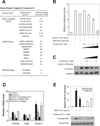High-efficiency induction of neural conversion in human ESCs and human induced pluripotent stem cells with a single chemical inhibitor of transforming growth factor beta superfamily receptors
- PMID: 20734356
- PMCID: PMC3322377
- DOI: 10.1002/stem.504
High-efficiency induction of neural conversion in human ESCs and human induced pluripotent stem cells with a single chemical inhibitor of transforming growth factor beta superfamily receptors
Abstract
Chemical compounds have emerged as powerful tools for modulating ESC functions and deriving induced pluripotent stem cells (iPSCs), but documentation of compound-induced efficient directed differentiation in human ESCs (hESCs) and human iPSC (hiPSCs) is limited. By screening a collection of chemical compounds, we identified compound C (also denoted as dorsomorphin), a protein kinase inhibitor, as a potent regulator of hESC and hiPSC fate decisions. Compound C suppresses mesoderm, endoderm, and trophoectoderm differentiation and induces rapid and high-efficiency neural conversion in both hESCs and hiPSCs, 88.7% and 70.4%, respectively. Interestingly, compound C is ineffective in inducing neural conversion in mouse ESCs (mESCs). Large-scale kinase assay revealed that compound C targets at least seven transforming growth factor beta (TGF-β) superfamily receptors, including both type I and type II receptors, and thereby blocks both the Activin and bone morphogenesis protein (BMP) signaling pathways in hESCs. Dual inhibition of Activin and BMP signaling accounts for the effects of compound C on hESC differentiation and neural conversion. We also identified muscle segment homeobox gene 2 (MSX2) as a downstream target gene of compound C and a key signaling intermediate of the BMP pathway in hESCs. Our findings provide a single-step cost-effective method for efficient derivation of neural progenitor cells in adherent culture from human pluripotent stem cells. Therefore, it will be uniquely suitable for the production of neural progenitor cells in large scale and should facilitate the use of stem cells in drug screening and regenerative medicine and study of early human neural development.
Conflict of interest statement
The authors indicate no potential conflicts of interest.
Figures




Similar articles
-
Small-molecule inhibitors of bone morphogenic protein and activin/nodal signals promote highly efficient neural induction from human pluripotent stem cells.J Neurosci Res. 2011 Feb;89(2):117-26. doi: 10.1002/jnr.22547. Epub 2010 Dec 8. J Neurosci Res. 2011. PMID: 21162120
-
Human Induced Pluripotent Stem Cell-Derived Cardiac Progenitor Cells in Phenotypic Screening: A Transforming Growth Factor-β Type 1 Receptor Kinase Inhibitor Induces Efficient Cardiac Differentiation.Stem Cells Transl Med. 2016 Feb;5(2):164-74. doi: 10.5966/sctm.2015-0114. Epub 2015 Dec 18. Stem Cells Transl Med. 2016. PMID: 26683871 Free PMC article.
-
Identification of the role of bone morphogenetic protein (BMP) and transforming growth factor-β (TGF-β) signaling in the trajectory of serotonergic differentiation in a rapid assay in mouse embryonic stem cells in vitro.J Neurochem. 2015 Feb;132(4):418-28. doi: 10.1111/jnc.12999. Epub 2015 Jan 23. J Neurochem. 2015. PMID: 25421849
-
Embryonic and induced pluripotent stem cells for lung regeneration.Ann Am Thorac Soc. 2015 Mar;12 Suppl 1:S50-3. doi: 10.1513/AnnalsATS.201410-457MG. Ann Am Thorac Soc. 2015. PMID: 25830836 Review.
-
Specification of neuronal and glial subtypes from human pluripotent stem cells.Cell Mol Life Sci. 2011 Dec;68(24):3995-4008. doi: 10.1007/s00018-011-0770-y. Epub 2011 Jul 24. Cell Mol Life Sci. 2011. PMID: 21786144 Free PMC article. Review.
Cited by
-
MSX2 Initiates and Accelerates Mesenchymal Stem/Stromal Cell Specification of hPSCs by Regulating TWIST1 and PRAME.Stem Cell Reports. 2018 Aug 14;11(2):497-513. doi: 10.1016/j.stemcr.2018.06.019. Epub 2018 Jul 19. Stem Cell Reports. 2018. PMID: 30033084 Free PMC article.
-
Human induced pluripotent stem cells are a novel source of neural progenitor cells (iNPCs) that migrate and integrate in the rodent spinal cord.J Comp Neurol. 2014 Aug 15;522(12):2707-28. doi: 10.1002/cne.23578. Epub 2014 Apr 12. J Comp Neurol. 2014. PMID: 24610630 Free PMC article.
-
Engineering efficient retinal pigment epithelium differentiation from human pluripotent stem cells.Stem Cells Transl Med. 2014 Nov;3(11):1295-304. doi: 10.5966/sctm.2014-0094. Epub 2014 Oct 1. Stem Cells Transl Med. 2014. PMID: 25273541 Free PMC article.
-
Combined small-molecule inhibition accelerates developmental timing and converts human pluripotent stem cells into nociceptors.Nat Biotechnol. 2012 Jul 1;30(7):715-20. doi: 10.1038/nbt.2249. Nat Biotechnol. 2012. PMID: 22750882 Free PMC article.
-
Generation of eye field/optic vesicle-like structures from human embryonic stem cells under two-dimensional and chemically defined conditions.In Vitro Cell Dev Biol Anim. 2015 Mar;51(3):310-8. doi: 10.1007/s11626-014-9835-1. Epub 2014 Nov 27. In Vitro Cell Dev Biol Anim. 2015. PMID: 25428201
References
-
- Thomson JA, Itskovitz-Eldor J, Shapiro SS, et al. Embryonic stem cell lines derived from human blastocysts. Science. 1998;282:1145–1147. - PubMed
-
- Yamanaka S. A fresh look at iPS cells. Cell. 2009;137:13–17. - PubMed
-
- Vallier L, Alexander M, Pedersen RA. Activin/Nodal and FGF pathways cooperate to maintain pluripotency of human embryonic stem cells. J Cell Sci. 2005;118:4495–4509. - PubMed
Publication types
MeSH terms
Substances
Grants and funding
LinkOut - more resources
Full Text Sources
Other Literature Sources
Research Materials

